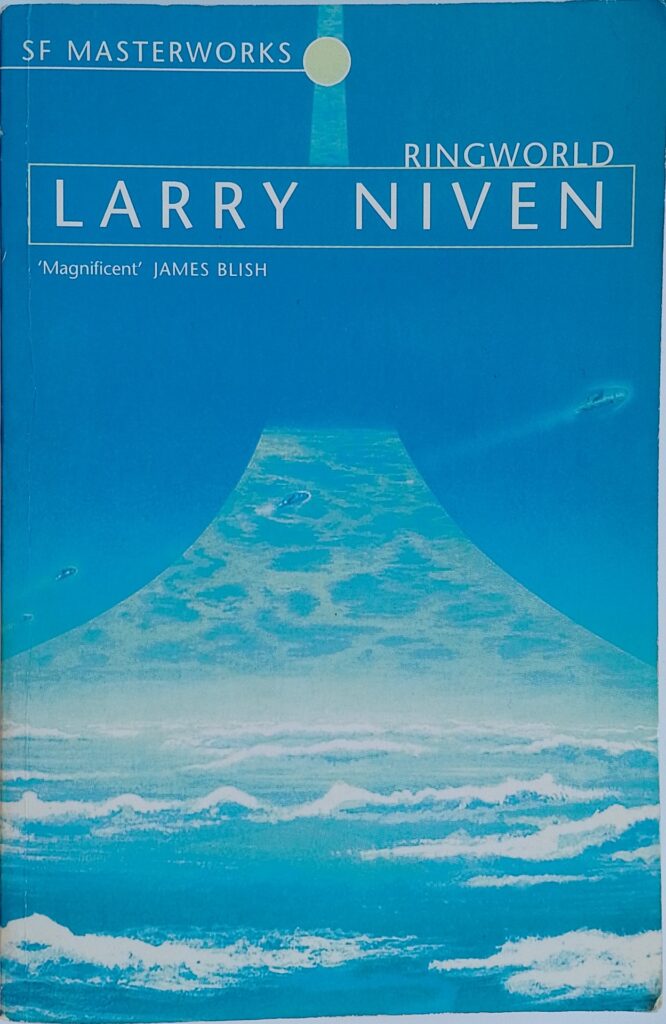First published 1970. Gollanz paperback, 2005, pp 288, c.95,000 words.
This is the book that gave Niven his breakthrough. He won the Hugo and the Nebula for it, as well as other awards. Later he went on to write three sequels as well as a lot of other SF. It stands up well as a very imaginative piece of work, but has now become something of a period-piece. The style owes much to the time in which it was written: the hippy heyday, bringing to mind Tom Robbins’ Even Cowgirls Get the Blues and Robert A. Heinlein’s Stranger in a Strange Land.
The setting is the far future and begins on Earth. Louis Lu is the protagonist, a two-hundred-year-old human, who has retained his youthful physic through treatments. While celebrating that milestone birthday, he becomes bored and leaves his own party, travelling round the world alone. He is approached by an alien, a legendary species of ‘puppeteer’ who are very rarely seen, and invited to come on a mysterious mission in the company of two others, one a twenty-year-old human woman and the other another alien species that is similar to a large, ferocious, intelligent cat. It turns out that the mission is to a mysterious object that the puppeteers have discovered far from human space. The object turns out to be a Ringworld.
Niven has great imagination. The alien species are suitably weird but somehow seem plausible, and he maintains their characters throughout. The puppeteers are highly risk adverse but have been an intelligent species for far longer than the others and have developed technologies well ahead of humans and kzin. The cat-like kzin are a war-loving species, always on the look out to take offence and resort to violence. In these two we have the extremes of the political spectrum: doves and hawks. Niven makes them both entertaining. The young woman has been selected for her luck. Her ancestors have won a world-wide breeding lottery for at least five generations. I was a bit inclined to go, oh yeah, beautiful twenty-year-old naïve female falls for two-hundred-year-old male, but it turns out there is something behind it all.
This is hard-SF in that the laws of physics apply, up to a point. There is the common SF assumption that in the far future it will turn out that we don’t know everything now. Faster-than-light travel will be possible, as will the generation of artificial gravity and some super-strong materials. However, there is no magic of wizards waving wands or wielding spells and potions. The physics of the Ringworld have been carefully worked out: its scale and construction are plausible, as well as its weaknesses. What happened to its inhabitants and ecology are well thought through. These things are cleverly covered in the story without ever coming across as a physics or engineering lesson. Each species has its own dietary requirements and habits and generally find that of the others repulsive. Food and drink is produced on demand by machinery but is of limited range. There are excellently invented words to give a sense of the future: drinks are consumed from ‘bulbs’, a ‘handmeal’ can be eaten as it says, a ‘tridee’ delivers entertainment.
Although the cast go rushing around from place to place, it seems as though this was more to do with providing another opportunity for Niven to display his first-rate inventive imagination rather than critical steps on the road to denouement. However, it does mostly come together in the end and all is explained. It doesn’t feel as though anything was deliberately left hanging for a sequel although the Ringworld is so vast there must be plenty more to explore.
Niven’s style is fluid and easy to read. It is not overloaded with psychological insight but does have its moments, e.g. ‘”We’re lucky, though. We can leave our mistakes behind us,” said Louis. “All we have to, do, any time, is get airborne. Nothing can catch us.” “Some mistakes we must carry with us,” said Speaker-To-Animals.’ Occasionally he is too keen to describe his invented tech. The capabilities of the ‘Slaver digging tool’, aka the ‘disintegrator’ are described twice.
This is a fun read. The style is light and breezy and there is an impressive imagination at work here. It still deserves its place as a seminal SF text.
© William John Graham, March 2023

